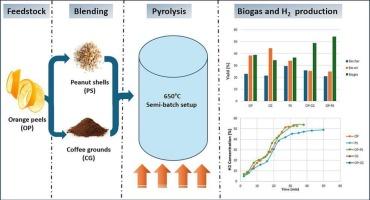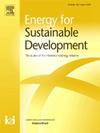通过橙子皮和农业废弃物共热解的可持续能源回收:产生富氢合成气、生物油和生物炭
IF 4.9
2区 工程技术
Q2 ENERGY & FUELS
引用次数: 0
摘要
本研究探索了橘子皮与典型的农业生物质残留物(如花生壳和咖啡渣)的热解和共热解。根据其相同的重量百分比,引用的样品与橙子皮以50:50重量%的比例组合。采用了两种技术配置:实验室规模的批量设置和工业规模的半批量设置。当实验由分批型过渡到半分批型时,挥发性副产物(包括生物油和沼气)的产率显著增加,其中橙子-花生混合物的产率达到79%。半间歇装置表明可冷凝馏分和不可冷凝馏分的转化效率都有所提高。因此,半批量配置被优先考虑,因为它具有生产高质量沼气的潜力。对于纯生物质热解,由于其挥发物含量高,橘子皮产生了最大的气体分数(38.83 wt%)。共热解结果进一步表明,在其他残渣中加入橘子皮对热化学行为有显著影响,导致沼气产量增加。具体来说,橙子-咖啡混合物的气体分数达到48.90 wt%,橙子-花生混合物达到54.20 wt%。特别是,橘子皮的掺入产生了创新的混合物,比单个生物质处理更早达到最大的氢气产量。就生物油组成而言,已建立的混合物导致较高的碳氢化合物浓度。值得注意的是,共热解过程提高了橘子皮和特定木质纤维素生物质废物的可行转化,因此根据循环经济和可持续废物处理概念,为其处理提供了独特的替代方案。这种方法可以作为一种可行的解决方案,支持发展中国家农村社区的能源复原力和社会经济发展。本文章由计算机程序翻译,如有差异,请以英文原文为准。

Sustainable energy recovery via co-pyrolysis of orange peels and agro-wastes: Generation of hydrogen-rich syngas, bio-oil, and biochar
This study explores the pyrolysis and co-pyrolysis of orange peels alongside typical agricultural biomass residues, such as peanut shells and coffee grounds. Based on their equal weight percentage, the cited samples were combined with orange peels in a 50:50 wt% ratio. Two technological configurations were employed: a batch setup at the laboratory scale and a semi-batch setup at the industrial scale. As the experiments transitioned from batch to semi-batch configurations, the yield of volatile byproducts, including bio-oil and biogas, showed a significant increase, peaking at 79 % for the orange-peanuts mixture. The semi-batch setup demonstrated enhanced conversion efficiency for both condensable and non-condensable fractions. As a result, the semi-batch configuration was prioritized because of its potential to produce high-quality biogas. As regards to pure biomass pyrolysis, orange peels yielded the largest gas fraction (38.83 wt%) due to their high volatile matter content. The results of co-pyrolysis further revealed that the addition of orange peels to the other residues significantly influenced the thermochemical behavior, leading to an increased biogas yield. Specifically, gas fractions reached 48.90 wt% for the orange-coffee blend and 54.20 wt% for the orange-peanuts combination. In particular, the orange peels incorporation generated innovative blends that reached maximal hydrogen production earlier than individual biomass processing. In terms of bio-oil composition, the established mixtures led to a higher hydrocarbons concentration. The co-pyrolysis process, notably, improves the viable conversion of orange peels and specific lignocellulosic biomass waste, providing thus a distinctive alternative to their processing in accordance with the circular economy and sustainable waste treatment concepts. This approach can serve as a viable solution to support energy resilience and the socio-economic development of rural communities in developing countries.
求助全文
通过发布文献求助,成功后即可免费获取论文全文。
去求助
来源期刊

Energy for Sustainable Development
ENERGY & FUELS-ENERGY & FUELS
CiteScore
8.10
自引率
9.10%
发文量
187
审稿时长
6-12 weeks
期刊介绍:
Published on behalf of the International Energy Initiative, Energy for Sustainable Development is the journal for decision makers, managers, consultants, policy makers, planners and researchers in both government and non-government organizations. It publishes original research and reviews about energy in developing countries, sustainable development, energy resources, technologies, policies and interactions.
 求助内容:
求助内容: 应助结果提醒方式:
应助结果提醒方式:


